Key FastBridge Tools for School Leaders
By: Barbara Scierka, Ph.D., Math Service Coordinator and Wendy Stuttgen, Ed.S., Literacy Service Coordinator at St. Criox River Education District
In this era of data-driven instruction, school leaders are called upon to integrate many types of information about student performance. The array of student data can be dizzying, but FastBridge Learning provides tools that leaders can use to make sense of student progress. As the school year winds down, building and district leaders are still busy planning for the following year. Certain FastBridge reports can assist leaders in identifying important trends from the current school year and set goals for the future. This blog provides step-by-step guidance about how leaders can evaluate data during the school year so that by June they will have a concise summary of the gains made and needs for the future. The FastBridge Group Screening Report by grade level and by teacher, the Group Growth Report by grade level and by teacher, and individual student progress monitoring graphs are key tools for leaders to make sense of this year’s data and map a course for next year. These steps will be explained in relation to each universal benchmark screening period.
Fall Benchmark Meeting
After the fall benchmark screening data have been collected, leaders should convene grade level team meetings to do the following:
-
-
- Identify the percentage of students meeting the benchmark target score at each grade level
- Set an end of the year goal to increase the percentage meeting the target
- Determine class wide medians and class-wide interventions
-
Here are data for a kindergarten team. The scores were sorted according to the following benchmark levels:
-
-
- College Pathway = 85th percentile and above
- Low Risk = 40th – 84th percentiles
- Some Risk = 15th – 39th percentiles
- High Risk = Below the 15th percentile
-
The fall scores showed that a majority of students were at some level of risk.

High Risk Some Risk Low Risk College Pathway
The next step is to identify the class median scores in order to identify which classes need Tier 1 core intervention supports. The median score is the middle score when all the scores for each class are rank ordered. The following table shows that the three classes all had median scores below the target. Having a class median score below the target means that half or more of the class has not met the benchmark learning goal.
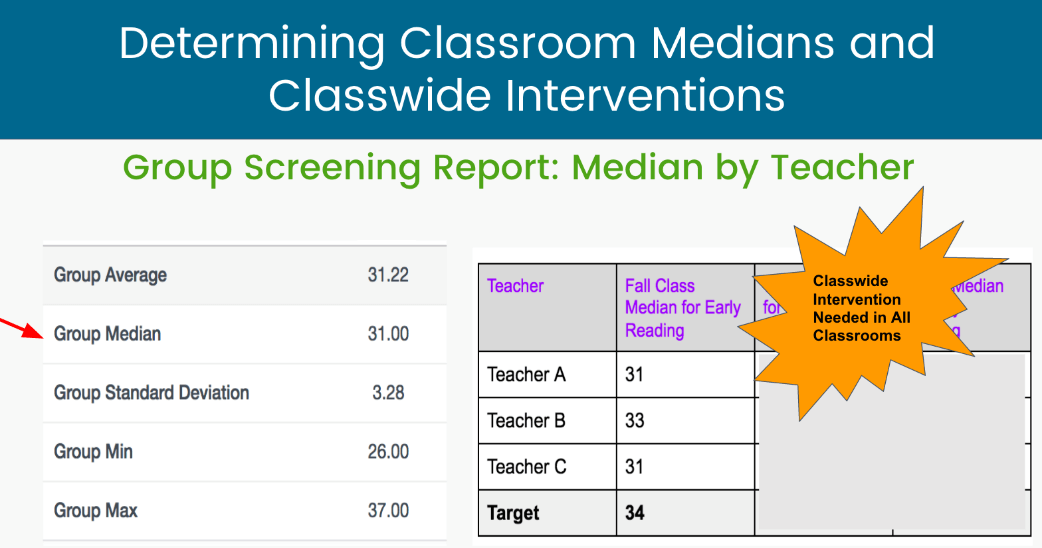
The next step is to determine how many students you can provide supplemental interventions based on available resources. Usually, each school can provide supplemental instruction for no more than 30% of students. When most of the students in each class are not meeting a benchmark goal, augmenting the core (Tier 1) instruction is the most effective practice. In this case, all of the classes needed class wide interventions (i.e., changes in core instruction).
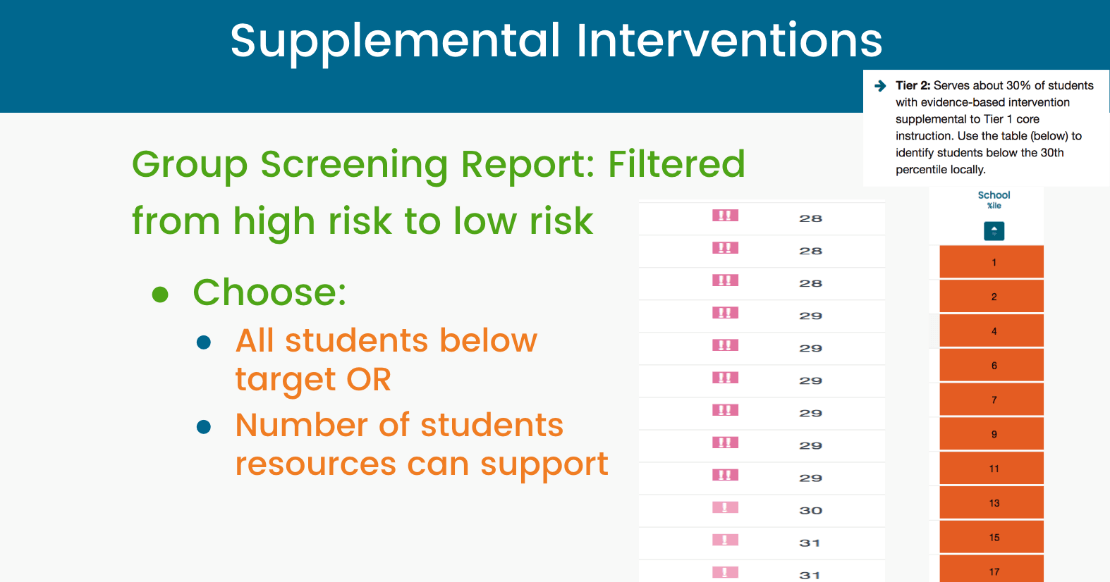
The next steps are to:
-
-
- Determine standard treatment protocol interventions based on students’ needs
- Set up progress monitoring
-
Standard treatment protocol interventions are practices that are readily available in the school for immediate use by staff with appropriate training to use them. All students who participate in intervention should be progress monitored on a regular basis (e.g., weekly) using a measure matched to the skills covered in the intervention.
Monthly Progress Monitoring Meetings
Between the fall and winter benchmark meetings, leaders should convene monthly meetings with each grade level team to review the effectiveness of interventions. To determine the effectiveness of each intervention, visually examine the progress graphs and decide if they show whether each student is making the rate of improvement (ROI) expected for that measure. Tally the results and calculate the percentage for each intervention and/or intervention group. Interventions are effective if approximately 80% of students receiving the intervention are making the typical ROI on their progress monitoring graphs. Here is a sample tally of progress data:

For students whose data indicate inadequate progress, the team should examine the details of the intervention and implement changes designed to boost results.
Winter Benchmark Meeting
After the winter benchmark screening data have been collected, grade level teams should reconvene and do the following:
-
-
- Determine percentage of students meeting target
- Was there an increase or decrease from fall-to-winter?
- Analyze size of growth for each grade to assess core instruction
- What type of growth did the majority of students make?
- Determine percentage of students meeting target
-
Looking at Growth by Grade helps to determine the effectiveness of core instruction. The FastBridge reports display the size and type of growth from fall-to-winter. At SCRED, we also like to look at growth by risk level (see table below) to analyze the relative gains of students starting at different points and to help with instructional planning (i.e., what kind of growth students at risk are making versus students who are already at target).

As before, the team should determine class wide medians and determine whether the class medians were higher or lower from fall-to-winter? For the kindergarten team in the example above the winter data were very impressive. After seeing the fall data, the kindergarten teachers at this school decided to put in place an intervention called Phonics Talks. The winter screening data indicated that all three classes had made sufficient improvements to be on track to meet the end of year benchmark goals.
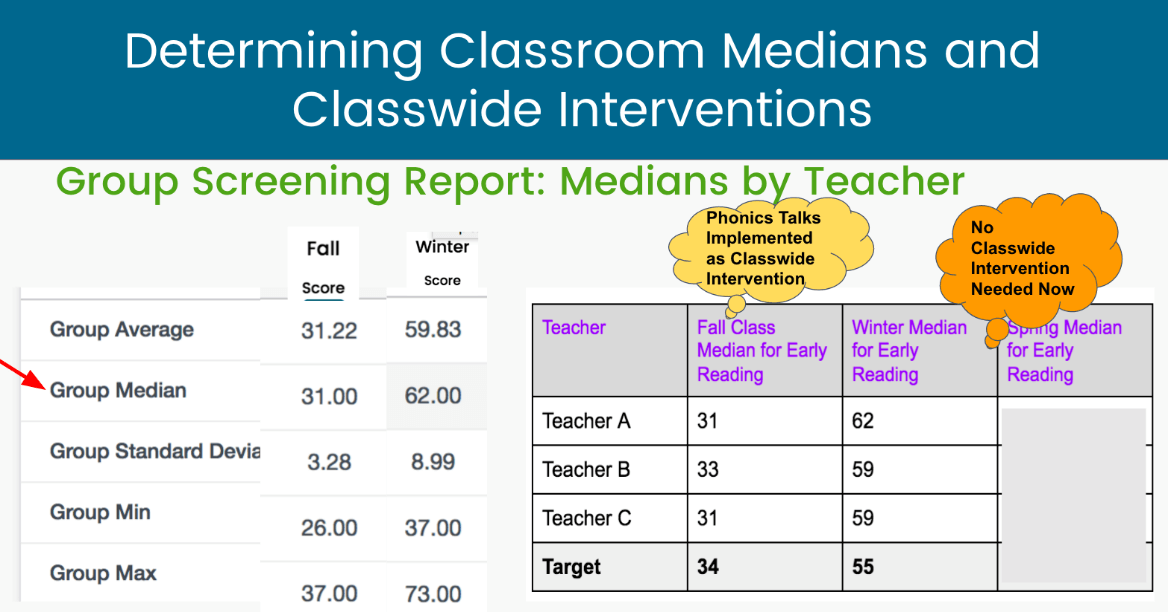
Based on these data, the grade level team decided that no additional class wide interventions for reading were needed.
At the winter benchmark data meeting, the teams should also review student growth data. In this case, the team reviewed the growth data for each kindergarten class to determine whether class wide interventions had an impact on student growth and whether there were differences in growth across teachers.
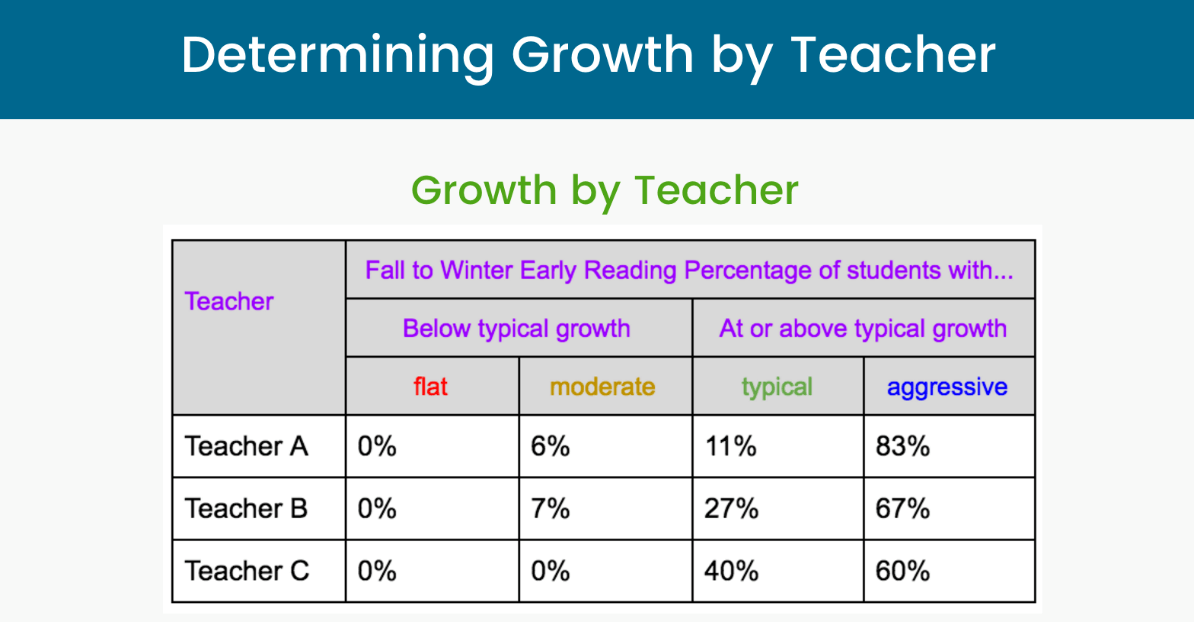
In the case of these kindergarten teachers, growth rates varied some, but were all very positive. Another question the team can ask is: whether there were differences in growth across interventions. In this case, the team examined whether students participating in different tiers of intervention (e.g., Tiers 2 and 3) had different growth rates. This review helps teams to hypothesize what is working and what needs to be changed.
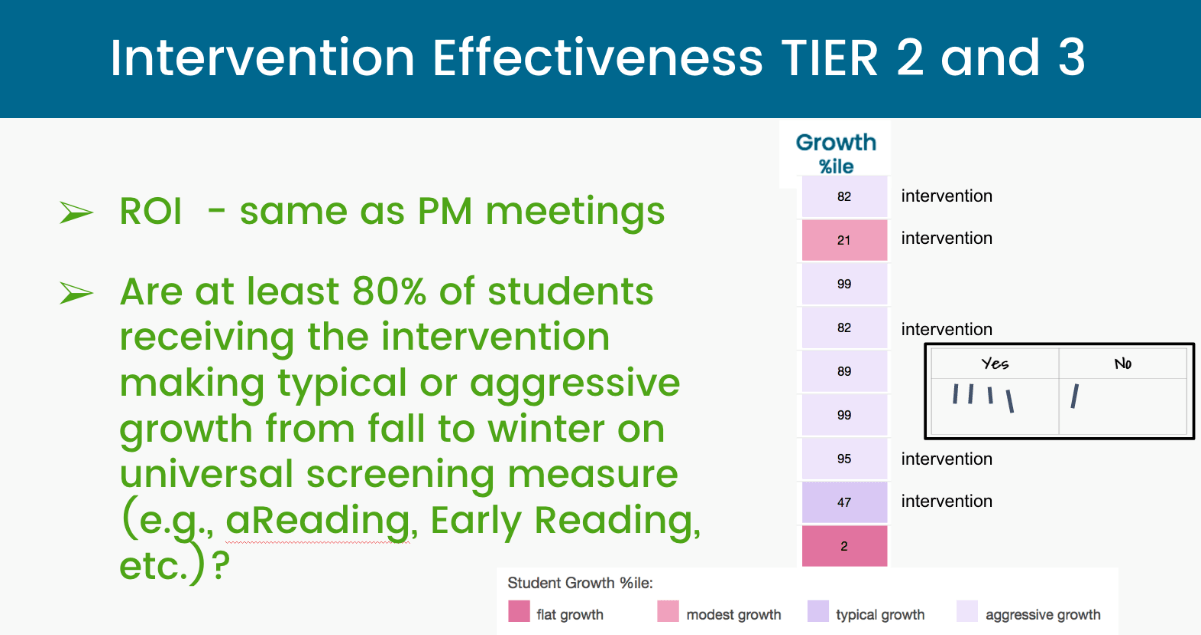
Monthly Progress Monitoring Meetings
Between winter and spring benchmark meetings leaders should resume monthly meetings with the entire grade level team to review the effectiveness of each intervention. To determine the effectiveness of each intervention, visually examine each progress graph, and decide if it shows the student is making the ROI expected for that measure. As before, tally the results and calculate the percentage for each intervention and/or intervention group. Interventions are effective if approximately 80% of students receiving the intervention are making the typical ROI. More details about typical ROI can be found in the online FastBridge benchmarks and norms tables.
Spring Benchmark Meeting
At the spring benchmark data review meeting, each grade level team will:
-
-
- Determine the percentage of students meeting target
- Was there an increase or decrease from fall-winter-spring?
- Compare results with the end of year goal
- Analyze size of growth for each grade
- What type of growth did the majority of students make?
- Determine class wide medians and growth
- Did class medians increase or decrease from winter-spring?
- Calculate growth by teacher
- Were there differences in growth across teachers?
- Determine the percentage of students meeting target
-
The answers to the above questions will help the team to determine if each grade level cohort of students is ready for the learning goals for the upcoming grade, or if interventions will be needed for all or some students as soon as the new school year begins. If interventions are needed, leaders should plan to organize class and grade-level teaching schedules to include time for such interventions, and provide professional development for all staff who will be expected to implement the interventions.
Summary of the School Year
In the fall, only 39% of this group of kindergarten students met the FastBridge earlyReading Composite target score (see first table). With so few students meeting the target, the kindergarten teachers quickly understood that they needed to strengthen their core instruction if they were going to get more students at target by spring. They worked as a team to develop non-negotiable instructional routines that were used systematically across classrooms. The specific core “intervention” was titled Phonics Talks and included 10 to 15 minutes of daily instruction teaching sound-symbol correspondence using letter/sound cards, smartboard activities, signaling, cueing, and immediate error correction. By the winter benchmark screening period, 85% percent of the students met the FastBridge earlyReading Composite target score, indicating their core instruction was highly effective. As a result, they continued with these instructional routines in all kindergarten classrooms. In the spring, 80% of the students were at the target score, reflecting the optimal percentage of student success. The kindergarten teachers were very excited with the progress their students made over the course of the year. The team reflected on their practices and decided to continue with Phonics Talks activities as part of their core instruction in future years.
As shown in this example, the systematic collection and review of universal screening data by grade level teams can result in important findings about students’ learning needs. In this case, a team of kindergarten teachers recognized that initial core teaching practices were not likely to meet the needs of their current students. In response to the finding that a majority of the students across all the classes needed different instruction, the teachers adopted a non-negotiable Tier 1 core “intervention” that included teaching phonics skills for 10-15 minutes each day. By the time of the winter screening period, the students’ scores revealed a very different pattern and 85% met the winter benchmark goal. The teachers maintained the phonics instruction for the rest of the year and by spring, 80% met the benchmark goal. This example documents how skillful leadership that includes and applies appropriate student data in regular conversations with grade level teams can result in powerful improvements in student learning.

